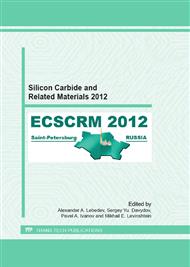p.145
p.149
p.153
p.157
p.161
p.167
p.173
p.177
p.181
Study of Carbonization Process on Surface of Si Substrate in High Vacuum Region with Hydrocarbon Gas
Abstract:
The formation mechanism of a carbonized layer was investigated under low-pressure and low-temperature process conditions. The initial carbonized layer under those conditions was formed epitaxially using the silicon atoms sublimated from substrate and the carbon atoms of the gas source. This result is suggested from the consideration of pit formation mechanism at the Si/SiC interface. After the initial layer was formed, the carbonized layer grew by the diffusion process of the carbon atoms through the crystal defects in the initially formed layer. This is suggested from that the thickness of the carbonized layer increases linearly with the square root of the process time. The growth rate seemed to be determined by the concentration of carbon atoms taken into the SiC.
Info:
Periodical:
Pages:
161-164
Citation:
Online since:
January 2013
Price:
Сopyright:
© 2013 Trans Tech Publications Ltd. All Rights Reserved
Share:
Citation:


